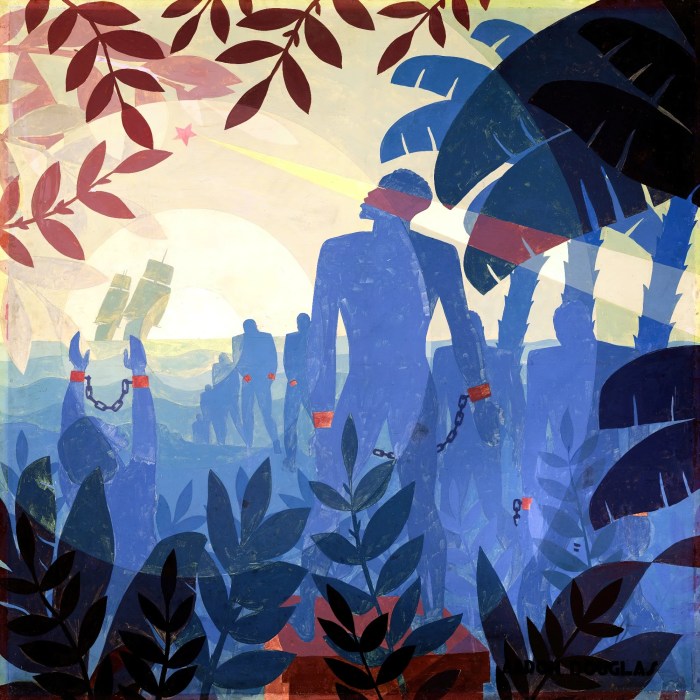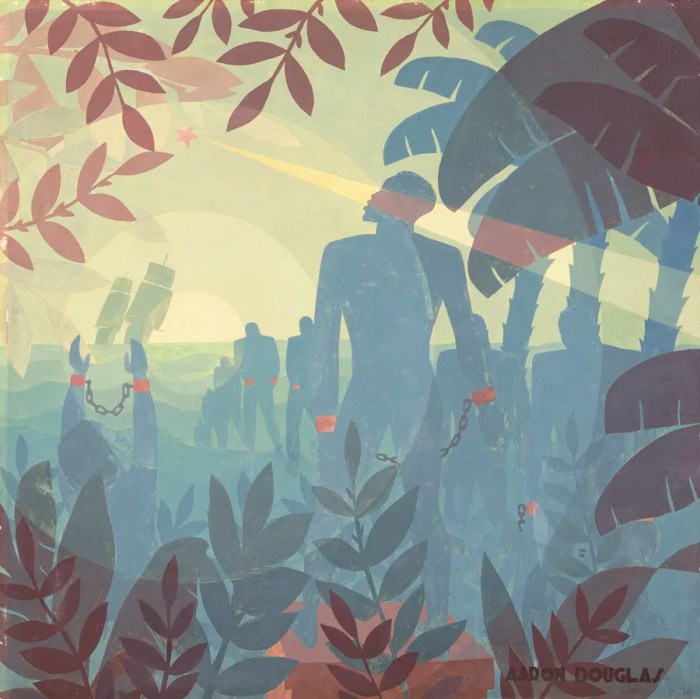Into Bondage by Aaron Douglas stands as a powerful testament to the Harlem Renaissance and its profound impact on African American art. Douglas’s iconic painting, with its evocative symbolism and masterful technique, captures the complexities of the African American experience during a pivotal era.
The painting’s depiction of African Americans reflects the social and political realities of the time, while its use of line, shape, and form conveys a powerful message about resilience and hope.
Historical Context

The Harlem Renaissance, a period of cultural and intellectual awakening for African Americans, emerged in the 1920s. This movement provided a platform for black artists, writers, and intellectuals to express their experiences, challenge racial stereotypes, and create a new African American identity.
Aaron Douglas, a prominent artist during this time, played a pivotal role in the movement. His distinctive style, characterized by bold geometric forms and symbolic imagery, became synonymous with the Harlem Renaissance and helped shape the visual identity of African American art.
Aaron Douglas’s Artistic Style, Into bondage by aaron douglas
Douglas’s art often explored themes of African American history, culture, and the struggle for equality. He used simplified forms, vibrant colors, and rhythmic patterns to convey powerful messages about the black experience.
- Geometric Forms:Douglas’s use of geometric shapes, such as circles, triangles, and squares, created a sense of order and balance in his compositions.
- Symbolic Imagery:He incorporated symbolic elements, such as the African mask, the spiritual, and the jazz musician, to represent the richness and diversity of African American culture.
- Rhythmic Patterns:Douglas’s compositions often featured rhythmic patterns that evoked the movement and energy of African American music and dance.
Through his innovative and evocative style, Aaron Douglas became a pioneer of African American art and helped establish its unique identity during the Harlem Renaissance.
Top FAQs: Into Bondage By Aaron Douglas
What is the significance of “Into Bondage”?
Into Bondage is a powerful depiction of the African American experience during the Harlem Renaissance, capturing the social and political struggles faced by the community.
How does Douglas use symbolism in the painting?
Douglas employs various symbols, such as the broken chains, the clenched fist, and the upward gaze, to convey themes of resilience, hope, and the struggle for freedom.
What is the impact of “Into Bondage” on the African American community?
Into Bondage has been instrumental in raising awareness about social issues and promoting racial equality, serving as a symbol of empowerment and a reminder of the community’s resilience.




Into Bondage by Aaron Douglas is a thought-provoking artwork that depicts the struggles of African Americans during the Jim Crow era. Like ellos caminan a la biblioteca , it showcases the challenges faced by marginalized communities. Douglas’s painting serves as a poignant reminder of the ongoing fight for equality and justice, echoing the spirit of resilience and determination captured in “Ellos Caminan a la Biblioteca.”